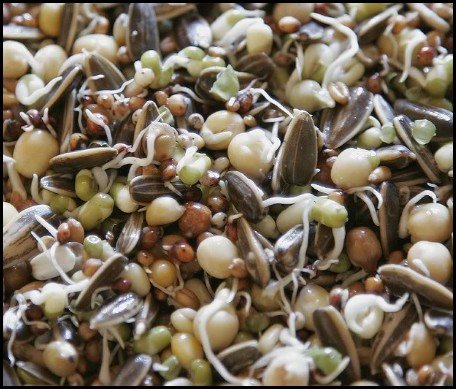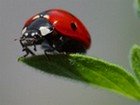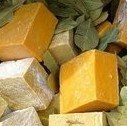6 Steps to Sprouting
Seeds using a
Sprouter Jar or a Sprouting Base
There are a number of grains and seeds that you can use for sprouting, but not all seeds can be sprouted, so this should be done with care. Any bean seeds can be sprouted; fava, soy, lima, pinto, garbanzos, etc. as well as peas, lentils, fenugreek, and alfalfa seeds.
So with some seeds and a sprouter jar or or sprouting base you can convert seeds into a highly nutritious meal. You can grow them anywhere, even on an apartment window sill as long as you have a jar, your seeds and some water. You can sprout just about any seeds and grains including mung, sunflower seeds, as well as grains such as rice and wheat, among others.
If you are using tap water, make sure that it has been pre-boiled and cooled first before you use it, and always use cool water, never warm water.
SPROUTING SEEDS with a Homemade Sprouter Jar
1. Wash your seeds well, and place them in a homemade glass sprouter jar.
2. Cover the seeds in the jar with water.
3. Then taking a small piece of gauze place it on the top of the sprouter jar and secure with a rubber band.
4. Pour off the excess water leaving the seeds damp.
5. Rinse the seeds daily in fresh water to prevent them from spoiling. Always pour off the excess water.
6. Remove from sprouter jar after the seeds have sprouted. Depending on the type of seeds used this could take anything between 2-8 days.
SPROUTING SEEDS: Using a Sprouting Base
1. Soak your seeds overnight in some water.
2. The next day drain the water off and place them in a single layer on some wet cotton wool.
3. Cover the seeds with an upturned bowl until they start to sprout.
4. Rinse seeds daily with gentle running water, making sure that the pressure of the water is not too great that you end up flushing the seeds away. This should be done 2 - 4 times a day, every day until your sprouts are ready.
5. Pour off the excess water leaving the seeds damp.
6. Harvest your seeds by cutting the stalks from the base.
Seeds suitable for this method of sprouting are mustard and cress, mung beans, lentils and wheat.
Harvesting, Storing and Eating Sprouts
Once they are ready for harvesting, put them in a plastic bag in the fridge and they will keep fresh like that for at least a week.
Of course, the sprouts have great nutritional value if you eat them raw. However, you can also cook your sprouts. Other than soybean sprouts which will need cooking a little longer, most sprouts should never be cooked longer than 5 minutes.
Sprouts are great to add to soups, casseroles, scrambled eggs or omlettes, quiches etc. but add these where you can just 3 minutes to the end of the cooking process to still maintain as many vitamins as possible.
But best of all, sprouts should be eaten raw. They are great added to salads and used on sandwiches and rolls and ideal for kids who don't like vegetables.

Which Seeds are Suitable for Sprouting and How Long will they take to Sprout?
| Seeds Suitable for Sprouting | |
|---|---|
| Alfalfa | 2-3 days |
| Fenugreek | 3-4 days |
| Clover | 2-3 days |
| Lentils | 3-4 days |
| Mung Beans | 4-8 days |
| Lima Beans | 4-5 days |
| Haricot Beans | 4-5 days |
| Sunflower Seeds (Hulled) | 1-2 days |
| Grains Suitable for Sprouting | |
| Wheat | 4-6 days |
| Brown Rice | 3-5 days |
| Buckwheat | 4-6 days |
| Barley | 3-5 days |
| Brown Rice | 4-6 days |
| Rye | 3-5 days |
| Buckwheat (hulled) | 3-4 days |
These are just some seeds that can be sprouted, and there are certainly many more. Cabbage, lettuce, pumpkin, peanut, popcorn, radish, turnip and spinach seeds can all be sprouted.
However, there are some seed sprouts that you cannot eat. Tomato seeds should never be sprouted, and you should never sprout seeds that are from packets intented to be used in vegetable gardens and these have been treated with poisons. Rather purchase your seeds from food stores.
SPROUTING SEEDS: Some Types of Sprouts for Sprouting
Alfalfa:
These are tiny sprouts that are sweet and delicious. They are very delicious, don't take too long to sprout and are also nutritious. They contain vitamins C, D, E and K plus iron and phosphorous. Your alfalfa sprouts are ready after they are about 2 inches high.
Adzuki:
These are high-protein beans that are sometimes used as a substitute for mung beans. They contain vitamins B1, B2, and niacin, potassium, iron and calcium. Adzuki sprouts can be harvested at 1 inch high.
Cress:
Cress is a peppery sprout that is quick growing and better grown off a base. It contains Vitamins A, B6, C, E and K. It is also a good source of thiamin and niacin, calcium, iron, magnesium, phosphorus, potassium, copper and manganese. Cress sprouts can be harvested after they have reached 1 inch.
Fenugreek:
A delicious tasting sprout. Eat it while it is still young as the older sprouts tend to taste slightly bitter. Contains vitamins A and C, and lots of iron. Fenugreek sprouts can be harvested between 1 - 2 inches.
Mung Beans:
One of the more popular sprouts, and certainly one of my favorites. It has a crunchy texture and is good eaten with a salad. It contains vitamins A, C, and E, plus chlorine, and lots of protein. Mung bean sprouts can be harvested between 1-3 inches high.Do you have any additional tips, ideas or questions regarding sprouting seeds?
If you would like to add something to this page on sprouting seeds all you need to do is type and submit. We will do the rest!Leave a Comment
Do you have anything that you would like to add after reading this page? We would love to hear your thoughts. If you can add additional information to what has been written here you will be adding value to the website! No need to have any special skills - just type and submit. We will do the rest!
Other Comments
Click below to see comments from other visitors to this page...
sprouting jars using canning jars Not rated yet
I have been growing sprouts for a little over a year now.
I use 6 regular wide mouth canning jars, the wide mouth ring for the jars, and wire screen, …










New! Comments
Do you have something of value to add? Leave me a comment in the box below.